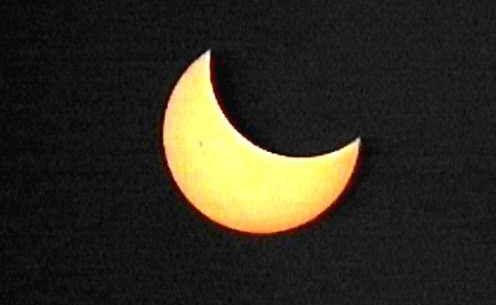Credit & Copyright: Olivier Staiger
Explanation:
Location is everything, especially if you want to see a
Solar Eclipse.
These
fleeting events
are only visible to those in the path of the Moon's shadow as
it races across the Earth.
This path is usually less than 200 miles wide while covering only a fraction
of a percent of the Earth's surface. And chances are, much of it will
be over water.
This view of the September 2nd eclipse was recorded
by Olivier Staiger from Kingscote, Kangaroo Island, South Australia.
He used a video camera
equipped with a teleconverter and solar filter.
This Solar Eclipse
was a partial one, seen here near maximum
for Staiger's location.
The deepest eclipse - almost 90 percent of the Sun's surface was
eclipsed by the Moon - was visible only from Antarctica.
Want to see a
total eclipse of the Sun?
Locate yourself near the northern tip of
South America on February 26, 1998.
1999 2000 2001 2002 2003 2004 2005 2006 2007 2008 2009 2010 2011 2012 2013 2014 2015 2016 2017 2018 2019 2020 2021 2022 2023 2024 2025 |
Yanvar' Fevral' Mart Aprel' Mai Iyun' Iyul' Avgust Sentyabr' Oktyabr' Noyabr' Dekabr' |
NASA Web Site Statements, Warnings, and Disclaimers
NASA Official: Jay Norris. Specific rights apply.
A service of: LHEA at NASA / GSFC
& Michigan Tech. U.
|
Publikacii s klyuchevymi slovami:
eclipse - Solnechnoe zatmenie - chastnoe solnechnoe zatmenie - Solnce - Luna
Publikacii so slovami: eclipse - Solnechnoe zatmenie - chastnoe solnechnoe zatmenie - Solnce - Luna | |
Sm. takzhe:
Vse publikacii na tu zhe temu >> | |
